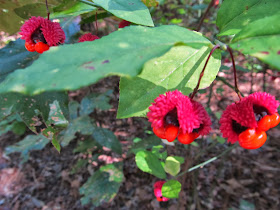Television...don't even get me started on some of the things I see and hear. There was something on Fox And Friends which was on just this morning and you may see it
here. If you can't stand to watch all of it, I can completely understand. "Bald Eagle Was Extinct, but Science Saved It". First of all, "extinct" means a species is NO LONGER LIVING, it is GONE forever! The wording should have been "Extremely endangered, possibly on the VERGE of extinction!" And to say that it only took a simple change on our part to change pesticides! I find it very hard to believe that they could not see fit to even MENTION the name of
Rachel Carson and the very difficult, uphill battle that she had to make this country understand the dangers of pesticides which she wrote about in her 1962 book, "Silent Spring". (And I think that are in need of another voice like hers in 2013!)
 |
Dusky Seaside Sparrow- Declared EXTINCT in 1990.
|
At Panola Mountain State Conservation Park, there is a protected open space called "Power of Flight" area. (Just recently, Panola Mountain was designated an official "IBA" which means "Important Birding Area".) For about 10 years now, they have done great work in restoring native grasslands in this area so as to attract more birds. The Atlanta Audubon Society also does bird bandings and bird counts there. Just this past Saturday, they asked for volunteers to hand-pick the native grass seed (Indian grass and blue-stem grass) and I am happy to tell you that I was one of the volunteers! (And this was just a really nice group of people, it was a pleasure to be with them.) In amongst the tall grasses, my partner and I were able to get enough grass seed into our pillowcase to make it quite heavy by the end of the day. The Indian grass was quite tall and we were told to take the seeds off gently by placing our thumb on one side of the stalk and our fingers on the other side and to lift up and that the seeds would come right off. (If they did not, they were not ready, not to force them.) The blue-stem grass seeds were like white, feathery tufts and for that, we turned the plant right into the pillow case and just shook them in. (And when I say pillow-case, it is just what you think, just a clean cotton pillow-case, they find it is the easiest way to collect the grass seeds.)
It was a lovely day. The Indian grass almost looked like stalks of wheat against a gorgeous blue sky and our small group gingerly walked in the thick grass with great purpose, placing the gathered seeds into our cases, with the soft sunshine shining down upon us, and a cool breeze blowing through the field. We did this for almost four hours but I had no sense of time. Now and then, a very large moth would quickly fly about and it looked so much like a hummingbird that it made me shake my head in wonder. I thought it must be some kind of moth, and I learned from a blog from Scotland, of all places, that it was a hummingbird hawk moth! (I say "of all places" because I understand they don't even have them in Scotland.) The things that we learn from blogs! I love it! Thanks, Bob from
blueskyscotland!
Charlie Muize, the IBA co-coordinator, was our leader for this volunteer grass seed collection. It was wonderful to hear his knowledge of birds and of this "Power of Flight" area. At the end of the day, he asked us did we know why we were collecting these seeds and we all said, almost at the same time together, "for the birds".
























